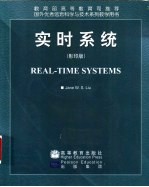

实时系统 英文本PDF电子书下载
- 电子书积分:18 积分如何计算积分?
- 作 者:Jane W. S. Liu著
- 出 版 社:北京:高等教育出版社
- 出版年份:2002
- ISBN:7040114062
- 页数:610 页
1 TYPICAL REAL-TIME APPLICATIONS 1
1.1 Digital Control 2
1.2 High-Level Controls 10
1.3 Signal Processing 14
1.4 Other Real-Time Applications 19
1.5 Summary 25
2 HARD VERSUS SOFT REAL-TIME SYSTEMS 26
2.1 Jobs and Processors 26
2.2 Release Times,Deadlines,and Timing Constraints 27
2.3 Hard and Soft Timing Constraints 27
2.4 Hard Real-Time Systems 29
2.5 Soft Real-Time Systems 31
2.6 Summary 32
3 A REFERENCE MODEL OF REAL-TIME SYSTEMS 34
3.1 Processors and Resources 35
3.2 Temporal Parameters of Real-Time Workload 37
3.3 Periodic Task Model 40
3.4 Precedence Constraints and Data Dependency 42
3.5 Other Types of Dependencies 45
3.6 Functional Parameters 48
3.7 Resource Parameters of Jobs and Parameters of Resources 51
3.8 Scheduling Hierarchy 52
3.9 Summary 56
4 COMMONLY USED APPROACHES TO REAL-TIME SCHEDULING 60
4.1 Clock-Driven Approach 60
4.2 Weighted Round-Robin Approach 61
4.3 Priority-Driven Approach 62
4.5 Effective Release Times and Deadlines 65
4.4 Dynamic versus Static Systems 65
4.6 Optimality of the EDF and LST Algorithms 67
4.7 Nonoptimality of the EDF and the LST Algorithms 70
4.8 Challenges in Validating Timing Constraints in Priority-Driven Systems 72
4.9 Off-Line versus On-Line Scheduling 77
4.10 Summary 81
4.11 Exercises 82
5 CLOCK-DRIVENSCHEDULING 85
5.1 Notations and Assumptions 85
5.2 Static,Timer-Driven Scheduler 86
5.3 General Structure of Cyclic Schedules 88
5.4 Cyclic Executives 90
5.5 Improving the Average Response Time of Aperiodic Jobs 92
5.6 Scheduling Sporadic Jobs 96
5.7 Practical Considerations and Generalizations 102
5.8 Algorithm for Constructing Static Schedules 106
5.9 Pros and Cons of Clock-Driven Scheduling 111
5.10 Summary 113
6 PRIORITY-DRIVEN SCHEDULING OF PERIODIC TASKS 115
6.1 Static Assumption 116
6.2 Fixed-Priority versus Dynamic-Priority Algorithms 117
6.3 Maximum Schedulable Utilization 124
6.4 Optimality of the RM and DM Algorithms 129
6.5 A Schedulability Test for Fixed-Priority Tasks with Short Response Times 130
6.6 Schedulability Test for Fixed-Priority Tasks with Arbitrary Response Times 140
6.7 Sufficient Schedulability Conditions for the RM and DM Algorithms 146
6.8 Practical Factors 159
6.9 Summary 179
7.1 Assumptions and Approaches 190
7 SCHEDULING APERIODIC AND SPORADIC JOBS IN PRIORITY-DRIVEN SYSTEMS 190
7.2 Deferrable Servers 195
7.3 Sporadic Servers 204
7.4 Constant Utilization,Total Bandwidth,and Weighted Fair-Queueing Servers 218
7.5 Slack Stealing in Deadline-Driven Systems 233
7.6 Slack Stealing in Fixed-Priority Systems 244
7.7 Scheduling of Sporadic Jobs 250
7.8 Real-Time Performance for Jobs with Soft Timing Constraints 259
7.9 A Two-Level Scheme for Integrated Scheduling 263
7.10 Summary 267
8 RESOURCES AND RESOURCE ACCESS CONTROL 277
8.1 Assumptions on Resources and Their Usage 277
8.2 Effects of Resource Contention and Resource Access Control 280
8.3 Nonpreemptive Critical Sections 284
8.4 Basic Priority-Inheritance Protocol 286
8.5 Basic Priority-Ceiling Protocol 290
8.6 Stack-Based,Priority-Ceiling(Ceiling-Priority) Protocol 300
8.7 Use of Priority-Ceiling Protocol in Dynamic-Priority Systems 304
8.8 Preemption-Ceiling Protocol 308
8.9 Controlling Accesses to Multiple-Unit Resources 313
8.10 Controlling Concurrent Accesses to Data Objects 317
8.11 Summary 322
9 MU TIPROCESSOR SCHEDULING,RESOURCE ACCESS CONTROL,AND SYNCHRONIZATION 330
9.1 Model ofMultiprocessor and Distributed Systems 331
9.2 Task Assignment 339
9.3 Multiprocessor Priority-Ceiling Protocol 352
9.4 Elements of Scheduling Algorithms for End-to-End Periodic Tasks 360
9.5 Schedulability of Fixed-Priority End-to-End Periodic Tasks 371
9.6 End-to-End Tasks in Heterogeneous Systems 384
9.7 Predictability and Validation of Dynamic Multiprocessor Systems 386
9.8 Summary 387
10 SCHEDULING FLEXIBLE COMPUTATIONS AND TASKS WITH TEMPORAL DISTANCE CONSTRAINTS 394
10.1 Flexible Applications 395
10.2 Tasks with Temporal Distance Constraints 411
10.3 Summary 417
11 REAL-TIME COMMUNICATION 420
11.1 Model of Real-Time Communication 421
11.2 Priority-Based Service Disciplines for Switched Networks 429
11.3 Weighted Round-Robin Service Disciplines 445
11.4 Medium Access-Control Protocols of Broadcast Networks 453
11.5 Internet and Resource Reservation Protocols 469
11.6 Real-Time Protocol 480
11.7 Communication in Multicomputer Systems 485
11.8 Summary 489
12 OPERATING SYSTEMS 497
12.1 Overview 498
12.2 Time Services and Scheduling Mechanisms 507
12.3 Other Basic Operating System Functions 523
12.4 Processor Reserves and Resource Kernel 534
12.5 Open System Architecture 538
12.6 Capabilities of Commercial Real-Time Operating Systems 549
12.7 Predictability of General-Purpose Operating Systems 556
12.8 Summary 564
APPENDIX POSIX THREAD AND REAL-TIME EXTENSIONS 571
BIBLIOGRAPHY 577
INDEX 589
- 《管理信息系统习题集》郭晓军 2016
- 《信息系统安全技术管理策略 信息安全经济学视角》赵柳榕著 2020
- 《系统解剖学速记》阿虎医考研究组编 2019
- 《慢性呼吸系统疾病物理治疗工作手册》(荷)瑞克·考斯林克(RikGosselink) 2020
- 《社会文化系统中的翻译》姜秋霞,杨正军 2019
- 《中国生态系统定位观测与研究数据集 森林生态系统卷 云南西双版纳》邓晓保·唐建维 2010
- 《大气氮沉降及其对生态系统的影响》方琨,王道波 2019
- 《学校教育指标系统的构建》杨向东著 2019
- 《系统故障 诗歌与影像》(中国)梁小曼 2019
- 《Access数据库系统设计与应用教程》李勇帆,廖瑞华主编 2019
- 《中风偏瘫 脑萎缩 痴呆 最新治疗原则与方法》孙作东著 2004
- 《水面舰艇编队作战运筹分析》谭安胜著 2009
- 《王蒙文集 新版 35 评点《红楼梦》 上》王蒙著 2020
- 《TED说话的力量 世界优秀演讲者的口才秘诀》(坦桑)阿卡什·P.卡里亚著 2019
- 《燕堂夜话》蒋忠和著 2019
- 《经久》静水边著 2019
- 《魔法销售台词》(美)埃尔默·惠勒著 2019
- 《微表情密码》(波)卡西亚·韦佐夫斯基,(波)帕特里克·韦佐夫斯基著 2019
- 《看书琐记与作文秘诀》鲁迅著 2019
- 《酒国》莫言著 2019
- 《全国高等中医药行业“十三五”创新教材 中医药学概论》翟华强 2019
- 《培智学校义务教育实验教科书教师教学用书 生活适应 二年级 上》人民教育出版社,课程教材研究所,特殊教育课程教材研究中心编著 2019
- 《指向核心素养 北京十一学校名师教学设计 英语 七年级 上 配人教版》周志英总主编 2019
- 《习近平总书记教育重要论述讲义》本书编写组 2020
- 《办好人民满意的教育 全国教育满意度调查报告》(中国)中国教育科学研究院 2019
- 《高等数学试题与详解》西安电子科技大学高等数学教学团队 2019
- 《北京生态环境保护》《北京环境保护丛书》编委会编著 2018
- 《教育学考研应试宝典》徐影主编 2019
- 《语文教育教学实践探索》陈德收 2018
- 《家庭音乐素养教育》刘畅 2018
